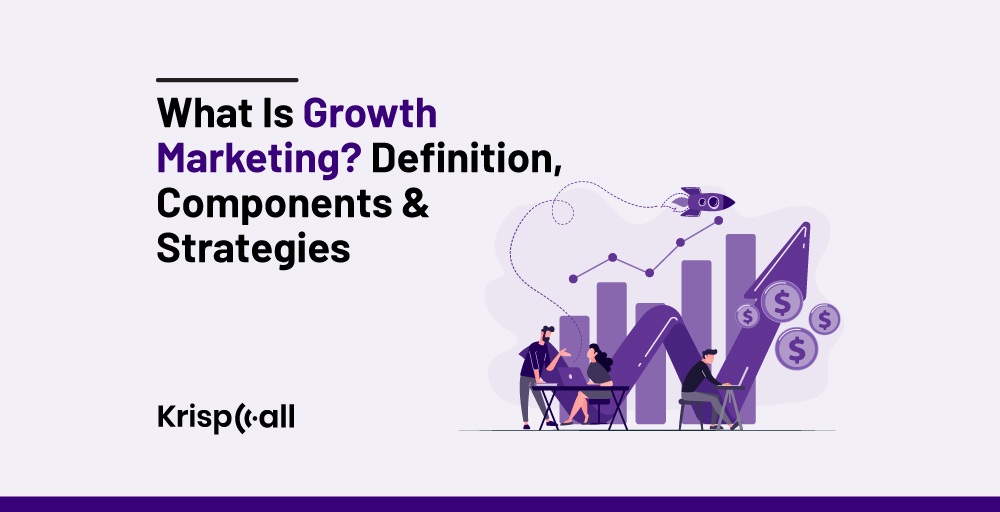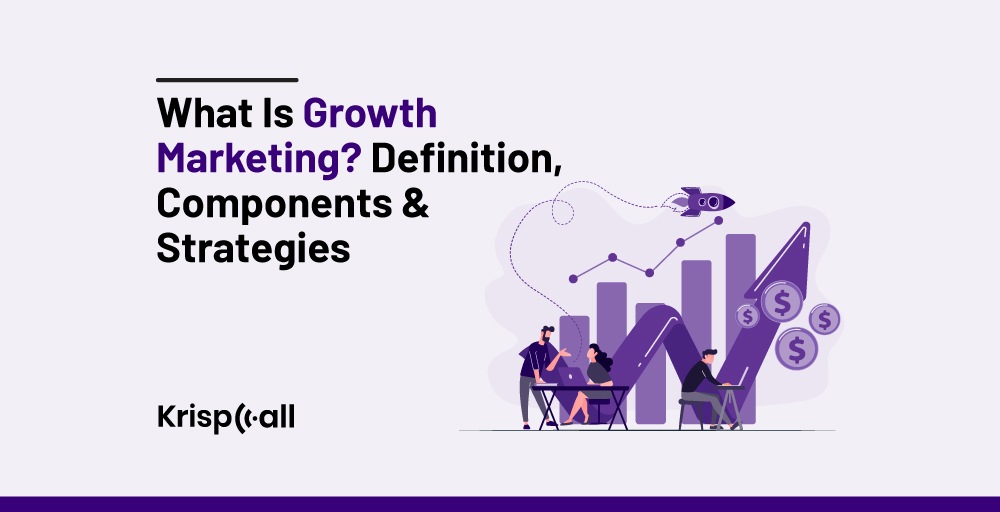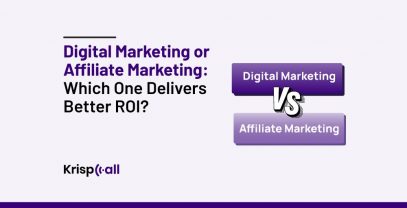Have you ever been surprised 😯by how fast some companies are growing? Well, Growth marketing is the secret behind it 😉.
Growth marketing is a modern customer-based approach that uses data to attract, engage, and retain customers for a long time by maximizing ⬆️ marketing efforts.
Unlike traditional marketing, which focuses on the top of the funnel, growth marketing strategy focuses on the entire customer journey, using data analytics and strategies to drive sustainable growth. 📈
By understanding the principles and strategies of growth marketing, businesses can cost-effectively unlock new expansion opportunities and achieve long-term success.
That’s why, In this blog, we will discuss growth marketing, including its clear definitions, key components, and strategies. We will also explore how growth marketing helps businesses expand fast.
Let’s get started. 🚀
🔑 Keyhighlights
- Growth marketing is a data-centric approach that attracts, involves, and retains customers by maximizing marketing strategies.
- Growth marketing focuses on the customer journey and maintaining long-term relationships with existing customers rather than acquiring new ones.
- Growth marketing drives sustainable growth, increases return on investment (ROI), improves brand awareness and builds loyalty, enhances customer experience, and maximizes customer retention rate.
- The core components of growth marketing are A/B testing, cross-channel marketing, the customer lifecycle, responsiveness and flexibility, and customer feedback.
- Implementing growth marketing includes setting clear goals, personalizing and targeting marketing, focusing on whole funnels, and choosing the right marketing tools.
What is Growth Marketing?
Growth marketing is a data-driven and experimental approach to the sustainable growth of the business. It involves identifying the best approach to attract, engage, and retain customers by testing and optimizing marketing methods and strategies.
Differing from traditional marketing, it focuses on long-term sales growth and strategies to retain customers, increase the brand image, and build loyalty. It involves elements like A/B testing, various channel marketing, data-driven decision-making mapping customer journeys, customer experiences, and feedback.

Growth marketing strategies aim to develop sustainable growth for the company and enhance the customer experience. They not only focus on attracting new customers but also involve strategies to engage and retain them for the long term. This ensures the highest return on investment (ROI) and long-term success for the business.
Moreover, It tests different ideas and methods, measures the results, and makes improvements to ensure a higher return on investment. It also optimizes every stage of the customer journey to improve their experience and retain, not just acquire, new customers.
What Does Growth Marketing Do?
Growth marketing experiments with marketing strategies and product developments that help optimize marketing efforts and increase a business’s growth rate.
It uses data derived from different campaigns and experiments and optimizes that data to reach more customers and increase a business’s conversion rate.
It optimizes a business’s marketing strategies and increases revenue. It offers high value to existing customers, retains them for a long time, and achieves long-term growth and customer loyalty.
Why is growth in marketing important? Key Benefits
Growth marketing is important because it drives business success by focusing on measurable growth, cost-effective customer acquisition, customer engagement, agility, and data-driven decision-making. It aims to grow the business by staying competitive and adaptive in a changing market.
Here are the key benefits of growth marketing:
1. Drive Sustainable Growth
Based on data and customer preferences, a growth marketing strategy maximizes marketing strategies and drives sustainable growth. Growth marketers continuously test and analyze to enhance their marketing strategy and adopt the market trend.
This marketing strategy not only focuses on attracting new customers but also focuses on retaining existing ones by creating a constant and stable growth approach for a business.
2. Increase ROI (Return on Investment)
Growth marketing can increase ROI (Return on Investment) by optimizing marketing efforts and contributions. Growth marketing chooses the target customers and offers personalized campaigns that can reduce the cost speed on guesswork.
Growth marketing involves continuous testing and analyzing that ensures the available resources are allocated in effective methods and channels. This belief in retaining existing customers more than acquiring new ones leads to an increase in ROI by saving money in attracting new ones.
3. Increase Brand Awareness and Build Loyalty
The ultimate goal of growth marketing is to improve a customer experience and increase brand awareness. Growth marketing identifies the best approach and channels, such as social media, blog posts, paid advertisements, etc, to engage target customers.
Furthermore, growth marketing conducts referral programs to encourage existing customers to promote the brand and reach people organically. It boosts visibility and creates brand loyalty among customers in the markets.
4. Enhance Customer experience
Growth marketing focuses on continuous optimization and personalization of the customer journey to enhance the customer experience. With data gained from the experiment, growth marketing teams can identify the best strategy, improvement areas, and pain points of customers.
Growth marketing understands customers’ behaviors and preferences and targets them with personalized experiences. Additionally, it improves customer experience through personalization and builds positive relationships and loyalty.
5. Improve Customer Retention throughout the customer journey.
Growth marketers use a data-driven strategy to analyze customer behavior and preferences and conduct a campaign to target customers.
Growth marketing engages customers with personalized and relevant content through various channels to retain them for a long time. Existing customers are more likely to spend by 31% compared to new customers. Growth marketing optimizes a customer journey, develops a strong relationship for the long term, and encourages customers to continue with their business.
Growth Marketing Vs Traditional Marketing
The main difference between growth and traditional marketing strategies is their goal and focus. Traditional marketing focuses on brand awareness and customer acquisition, whereas growth marketing focuses on the customer journey.
Traditional marketing focuses on the products and sales, marketers efforts to promote products to a huge audience. In contrast, the growth marketing strategy is customer-centric; growth marketers understand customer needs and preferences and make marketing efforts to meet their expectations.
Unlike traditional marketing, which aims to get more traffic or increase the number of purchases and leads, growth marketing aims to improve whole marketing funnels from awareness to beyond retention.
Another difference between growth and traditional marketing is strategy and approach. Traditional marketing is based on demographic data and assumptions, whereas growth marketing is based on real-time data and experiments. In contrast, growth markers avoid guesswork and reduce risk to drive business growth.
Key Components of Growth Marketing
The key components of growth marketing are mentioned below:
1. A/B testing
A/B testing is one of the core components of growth marketing. It is a process of testing different marketing methods to identify the best one. It compares two methods to find the most effective approach to maximizing conversion rate and customer engagement.
Moreover, this helps marketers reduce guesswork and make quick decisions. It drives sustainable growth in sales, improves customer experience, and increases return on investment (ROI) in business.
2. Cross-channel marketing
Cross-channel marketing simply refers to using various marketing channels to promote a product by implementing a marketing strategy that fits with customer’s preferences. It is applied to communication channels like emails, text messages, social networks, and messages in applications.
Also, it is important to note that for marketers to integrate cross-channel communication effectively, they need to understand their customers’ preferred communication channels. This can enable the identification and monitoring of customer activities that are very helpful in improving brand exposure and customer interactions.
3. Customer lifecycle
Anticipation and adaptability in growth marketing also refer to the notion that one has to stay prepared for market shifts and users’ actions. In this case, the information requires constant updates with new trends, technologies, and the competitor’s activities to sustain competitiveness.
In addition, applying a reaction and fluidity enables marketers to experiment incessantly and implement changes in their approaches if necessary. This makes markets more effective and timely in conducting marketing campaigns due to the agility and innovation it fosters.
4. Responsiveness and flexibility
Growth marketing necessarily implies responsiveness and flexibility, especially regarding market trends and customers. This means being able to shift gears whenever needed and counter or match new trends, technology, or competitor actions to achieve a competitive advantage.
In addition, more confusing and elastic strategies are possible for testing new approaches to the problem, transitioning from one approach to another in the middle of the project, and gradually increasing marketing efficiency. This allows for flexibility, new ways of thinking and doing business, and overall efficiency in marketing communication.
5. Customer feedback
Customer feedback is important in growth marketing because it highlights what customers like, dislikes, or expect from a brand. By acquiring and responding to feedback, marketers should be able to boost product innovations as per customer demand and preferences.
Furthermore, gathering and analyzing customer data assists in discovering what can be done to enhance the customer experience. It centralizes the customers in the overall marketing planning process so that strategies can be taken to improve customer service.
Examples of Growth Marketing Campaigns
Here are some leading examples of growth marketing campaigns that marketers can use to attract, engage, and retain customers for large-scale business growth. They are:
1. Top of the funnel engagement
Top-of-the-funnel engagement (TOFU) marketing campaigns are developed to attract potential customers and raise awareness about your brand. These campaigns are used to reach a broad audience and attract them to purchase products and services. Some examples of these marketing campaigns are social media campaigns, content marketing, and search engine optimization (SEO).
Content marketing, such as blog posts, case studies, videos, and infographics, lets you engage and provide more information about your brand and products. You can also use social media platforms like Facebook, Instagram, and LinkedIn to attract more customers and create awareness about your brand.
2. Onboarding
Onboarding campaigns mean guiding new customers to make their purchases. They involve helping interested customers understand and get value from your products. Effective onboarding programs can reduce churn rates and increase user experiences and satisfaction.
Onboarding programs include sending personalized emails and texts to customers to introduce your products and brands. You can also explain the advantages of purchasing products and services. Creating tutorial videos also helps customers to understand how your product works.
3. Referral programs
Referral programs encourage and motivate existing customers to retain and drive new customers. Customers trust recommendations from friends, family, and relatives more than advertisements, so this type of program can be effective in creating a powerful growth loop.
Referrals are free marketing for a business that creates a loyal customer network. Discounts, credits, and cash rewards are incentives that motivate existing customers to retain and suggest your products to others.
How to Create Growth Marketing Campaigns?
Growth marketing is not one event. Creating growth marketing campaigns is a continuous process of experiments to optimize marketing efforts.
Here are some steps to create a growth marketing campaign:
1. Setting Clear Objectives
Setting objectives is one of the more important preparations before creating a growth marketing campaign. These objectives could include driving more web traffic, more downloads, more email sign-ups, and better customer loyalty. Objectives clearly outline your campaign’s direction and indicate evaluation measures.
2. Understand Your Audience
Growth marketing managers should study the characteristics of the targeted customers in terms of demographics, behaviors, challenges, and preferences. To get data, questionnaires, social media monitoring, and competition research were used. Knowing your customers is always helpful, as you can use personalized messages and strategies to influence them.
3. Develop a Value Proposition
Develop a persuasive value statement to clearly explain what defines your offering and its usefulness to consumers. This statement must aim to meet your audience’s needs and offer a unique proposition compared to your rivals. A great value proposition captures the client’s attention and leads him to act.
4. Choose the Right Channels
Consider the best channels for contacting target consumers. These could include social media marketing, e-mail marketing, content marketing, SE optimization, Paid-per-click, and many others. The characteristics of the various channels also apply, including the fact that they have different roles and can reach different groups of your audience.
5. Create Engaging Content
Create and share well-written and memorable content that reflects your audience’s interests and communicates the campaign’s objectives. This could range from an article to a blog post, a YouTube video, an infographic, a podcast, or other engaging content. Interesting content grabs attention, inspires trust, and prompts people to share information or links, leading to content awareness.
6. Optimize for Growth
Track the outcomes of the campaigns you launch and always try to find ways to improve them. This could, at times, require refining the target market, modifying the strategy and proposition, or testing new distribution and media types. The cited aspect maintains the effectiveness of the campaigns over time.
8. Foster Customer Relationships
From a strategic perspective, focusing on developing long-term cooperation with customers based on their satisfaction, personalized communication, and client reward programs is advisable. This is a true statement because fans and customers will buy the brand’s products repeatedly and refer more customers to it.
9. Evaluate and Repeat
Consequently, assess the campaign’s impact after it had ended to see whether it met the goals you set when you were coming up with the campaign. Determine the overall effectiveness of the business and what measures that were successful and which were not so successful should be part of future campaigns. The two processes outline how future campaigns might be arranged to produce better results in later years.
How to Implement a Successful Growth Marketing Strategies?
Steps to Implement a successful growth marketing strategy are as follows:
1. Set Clear Goals and Objectives
First, the growth marketing manager must set a goal or objective for the growth marketing. The goals and objectives may be increasing customer satisfaction and retention, increasing sales volume and revenue, building loyalty, etc.
A goal must be specific, measurable, achievable, relevant, and time-bound. Ensure that your goals must align with your business vision or mission statement.
2. Make Data-driven Decision
Successful growth marketing doesn’t depend on the guesswork. Decisions and data should be based on the data and tested results from the marketing campaigns. Data plays an important role in customer acquisition and retention.
So, data quality must be accurate, relevant, and reliable for successful growth marketing strategies. You can leverage powerful tools to gather and analyze data to make data-driven decisions and strategies.
3. Use of Data Analytics Tools
Marketing managers should use various data analytics tools to track and analyze data before developing a strategy for growth marketing. Examples: Google Analytics, HubSpot, Semrush, Microsoft Power BI, Zoho Analytics, etc.
These data analytics tools help make better customer acquisition and retention decisions. Collected data should be used to develop a growth marketing strategy. Such a data-driven strategy brings positive effects on business growth and innovation.
4. Utilize Multi-Channel
Growth marketers can choose both online and offline marketing channels. Diversify your channels as much as possible to reach a wider audience.
You can use channels such as social media, email, search engine optimization (SEO), paid advertisement, content marketing, text messages, social networks, etc. Experiments with different channels to check which works effectively for your business to promote your products.
5. A/B Testing and Experimentations
For a successful growth marketing strategy, you should conduct experimentation and A/B tests. These help you make data-driven decisions, optimize marketing plans, and maximize conversion rates.
In A/ B testing, you can create two variations of marketing strategy and implement them in different groups of customers to determine which method is most effective for optimizing the conversion rate and engaging more customers in funnels.
6. Engage and Retain Customers
Retaining customers is cheaper than acquiring new ones. Acquisition costs businesses five to seven times more than retaining existing customers. According to Hubspot, increasing customer retention by 5% can increase revenue by 25–95%. Convincing existing customers is easy and cost-effective.
Retained and loyal customers are more likely to spend more money to buy than new ones. So, invest in a strategy to engage and retain your existing customers to maximize your sales and revenue.
7. Personalization and targeted marketing
Businesses should implement a personalized and targeted marketing strategy for successful growth marketing strategy. You must understand the customer’s preferences and behaviors to deliver personalized customer experiences.
A personalized growth marketing strategy ensures that marketing campaigns meet customers’ expectations, interests, preferences, and demands. It helps enhance customer experiences and increase customer acquisition and retention.
8. Focus on the Whole Marketing Funnel
Marketing funnels include steps from awareness to retention and loyalty. Growth marketing funnels are the key to tracking a customer journey and identifying the best way to improve it to build long-term customer relationships.
A growth marketing strategy should focus on the customer journey, not only creating awareness. Growth marketing should aim to focus on every customer touch point in every stage of the funnel to convert them into leads.
10. Choose the Right Tools for Marketing
Selecting the right marketing tools is important for a successful marketing strategy. The right marketing tools allow for the effective implementation of marketing campaigns. You must select the tools that fit your workflows and help you achieve growth in your business.
These tools offer streamlined automation, precise targets, real-time performance tracking, and more. Moreover, marketing tools ensure sustainable growth, an increase in ROI, teamwork, better resource allocation, and valuable data insights.
Conclusion
Growth marketing is a data-driven approach that goes beyond traditional marketing. It focuses on entire funnels from acquisition to revenue. For its successful strategy, growth marketing includes A/B testing, cross-channel marketing, customer lifecycle, responsiveness and flexibility, and customer feedback.
Moreover, It uses different marketing channels, such as social media, paid ads, blogs, emails, etc., to engage and retain customers. It also unlocks more opportunities and ways for organic business growth and innovation by ensuring constant growth, increasing the ROI, and improving customer retention.
In addition, it is a sustainable approach for optimizing marketing efforts and strategies to drive business growth and innovation.
FAQ
What is the difference between growth marketing and performance marketing?
The difference between growth marketing and performance marketing is focus and marketing channels. Growth marketing focuses on building long-term business growth by developing a strong customer relationship, whereas performance marketing focuses on attracting and converting them into new customers.
In addition, growth marketing depends on marketing channels like social media, emails, and content. In contrast, performance marketing focuses more on paid platforms such as Google Ads, LinkedIn Ads, and Facebook Ads.
What is the difference between growth marketing and product marketing?
The difference between growth marketing and product marketing is its process and aims. Growth marketing is a data-driven experimentation approach to identify the best marketing strategy for growth opportunities, customer retention, and long-term customer relationships.
On the other hand, product marketing is a process of introducing and creating awareness of your products and services to consumers to boost the sales volume.
What is the growth marketing process?
The growth marketing process is a comprehensive funnel approach to marketing that involves continuous experimentation across various marketing channels. It focuses on a whole customer lifecycle that includes setting goals to guide marketing efforts and mapping different stages of the customer journey.




